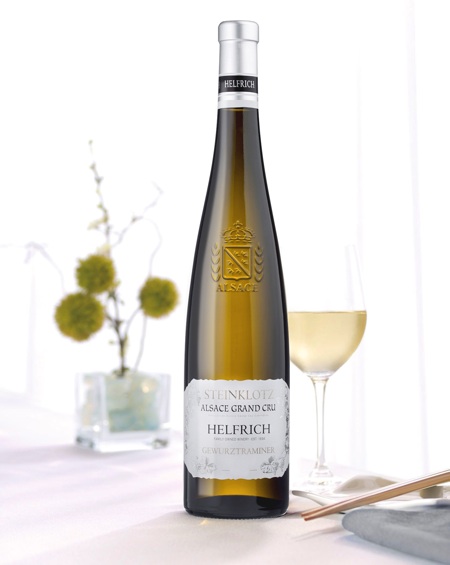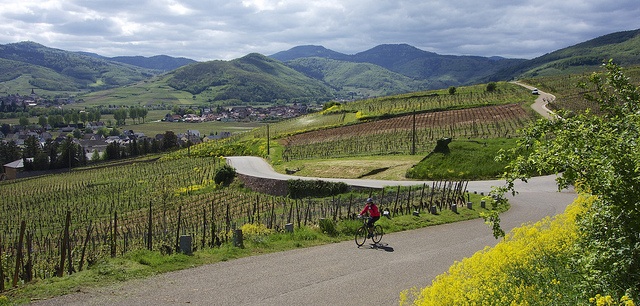
Historically and geographically poised between French and Germanic cultures, the wines of Alsace take their cues from both traditions — mostly German varietals, mostly French vinification techniques. The region, which is the second most Northern winegrowing region (just after Champagne) in France, is best known for it’s dry whites, but also produces lively and delicate sparklers, and full-bodied reds. My great great grandfather Gustave hailed from Strasbourg, so I’ve always had a soft spot for this sometimes complicated region, especially it’s food — flammekueche and choucroute — and drink. When Anne-Laure Helfrich and Nicolas Haeffelin of Helfrich Winery were in town recently, I took some time to taste through some of their current vintage and learn a little bit more about this unique terroir.
Both Helfrich and Haeffelin have deep roots in the region. Anne-Laure is a six-generation Alsatian and the third generation involved in winemaking, beginning with her grandfather who made kirshwasser and plum brandies and continuing with her father Joseph, who in 1979 made the family passion a profession by founding Les Grand Chais de France, which has since become one of the most successful wine companies in France. She is currently responsible for the development and marketing of Helfrich wines in the U.S. market. Nicolas is also continuing a family tradition — the Haeffelin family has been established in Alsace in the early 16th century and has produced a winemaker in every generation since 1560. Which somehow makes my plan to make some hooch using my great grandmother’s Prohibition era bathtub gin recipe suddenly seem so much less like an impressive legacy. Haeffelin is in charge of winemaking at both Domaine Viticole de la Ville de Colmar (his familial winery, which joined the Grand Chais de France Group in 2011) and at the Helfrich/Arthur Metz winery.
Alsace has had a winemaking culture since Roman times — in 56 B.C., Caesar himself called the vineyards of Alsace “Optimus Totius Galliae.” Which if you aren’t so big on the dead languages means “the best of all Gaul.” A 2 hour trip from Paris on the TGV, the vineyards of Alsace run north to south along the Vosges Mountains, which creates a unique micro climate. The mountains create a protective shield from both the oceanic breezes and excessive rainfall, which makes for a long cool growing season. That combined with the diverse soils, ranging from rose-colored sandstone to volcanic rocks, chalky clay, schist, limestone and granite makes for a long cool growing season and aromatic wines with great acidity and minerality.
What we tasted:
Helfrich Cremant d’Alsace “This wine is a particularly good value” pointed out Anne-Laure as we sipped this mild and elegant straw yellow bubbly. The wine is made by the traditional method, starting with hand harvested Pinot Blanc grapes. Before aging on the lees for three months, the winemakers carry out an alcoholic fermentation under controlled temperatures. The wine is then bottled for the prise de mousse, or second fermentation. “Alsatian law requires only 12 months for aging on the lees, but we keep them aging for 24 months, for finer bubbles and a clean finish.” The resulting wine is fresh and fruity with a clean and refreshing finish.
2012 Helfrich Pinot Blanc “No Alsatian would ever be without a bottle of Pinot Blanc in the fridge” agree Anne-Laure and Haeffelin. The grapes for this wine come from the vineyards that are sloped with a South/Southeast exposure and calcareous soils. Post harvest they go through up to 2 weeks of cold fermentation before being racked on fine lees, which helps build a round and full body, with great acidity and aromas of lemons and pine.
2012 Helfrich Riesling The sloped vineyards, calcareous soils, and the long, cool and dry growing season of the region are all particularly perfect for Riesling. After harvest, the grapes are destemmed, a the juice is cool fermented in stainless steel before being settled cold, racked on fine lees. This makes for a crisp wine with well-balanced acidity. A steely wine with chalky minerality and hints of mandarin.
2012 Helfrich Pinot Gris This Pinot Gris is true to the region. Rich and full bodied, with an almost opulent mouthfeel. The wine has notes of peach and melon and a smoky hit of spice.
2012 Helfrich Gewurztraminer Gewurtztraminer is the quintessential Alsatian varietal, it thrives in the region’s terroir — long cool growing seasons and mineral-rich but thin soils. Fermented in stainless steel, this wine is aromatic and uber floral, with notes of lychees and passion fruit.
2011 Helfrich Riesling Grand Cru These grapes are from the Steinklotz vineyard, on of only 51 vineyards in Alscace that hold the Grand Cru designation. By law, only Riesling, Pinot Gris, Muscat and Gewurztraminer may be grown in these vineyards. It is one of the oldest vineyards recorded in the region and was reported to have belonged to the Merovingian King Childebert II back in 589 AD. The grapes are dry-farmed, as per Alsatian law, and handpicked in October and November before being put through membrane pressing and cool fermented in stainless steel. The rich, golden wine is bright and racy with notes of fruit, white flowers and citrus and a great minerality.
2011 Helfrich Pinot Gris Grand Cru Also from the Steinklotz vineyard, this wine is round, rich and complex, with a sweet smokiness, high acid, and a fruity core. Haeffelin said that this wine was one that could age for up to 20 years.
2009 Helfrich Gewurztraminer Grand Cru This wine, also from the Steinklotz vineyard, was rich, opulent and complex with hints of honey and candied clementine.
 Photo by will_cyclist
Photo by will_cyclist